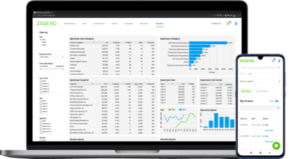How ZAGENO Integrates with AP Systems to Streamline Biotech Finance

In recent years biotech finance and overall lab operations have undergone a digital transformation.
With advancements in the biotech, biopharma, and life sciences space, lab managers and finance teams are navigating an increase in the number of suppliers labs are using, the need for automated tracking of lab supplies due to supply chain challenges, and competition among fellow researchers for available products. Enter: automated, integrated lab systems with real-time data.
For biotech finance and accounting teams, lab automation solves the challenges of adding on new vendors and purchasing more frequent supply orders, along with other previously manual processes, like procurement. Here’s how lab finance teams can use ZAGENO’s AP system integrations to streamline accounting workflows.
New Needs of Biotech Finance Teams
The current spotlight on the biotech industry is illuminating many areas of growth for finance teams. Increases in government grants — beginning with the CARES Act in March 2020 that supplied the National Institute of Health with $940 million in supplemental funding— as well as an increase in acquisitions and partnerships — between 2019 and 2020 the biotech industry saw double-digit growth in fundraising from VSs — have made this a banner period of small and emerging biotech labs.
As the finance teams of these labs work to manage their fluctuating or newly inflated budgets, many are eager for software solutions capable of easing the manual workload for themselves and their teammates.
The needs of the modern biotech lab finance team has changed. Gone are the days of manual invoice management and approval workflows. The focus is now on automating systems in order to optimize accounting workflows. To keep up with the demands of growing pre-clinical R&D teams, finance teams are using tools like digital marketplace integrations with AP systems to approve, track, and document lab supply orders.
How Biotech Finance Teams are Navigating the Supplier Boom
One of the largest areas of growth that biotech labs have seen in recent years is an influx of suppliers. Not only has the aforementioned government investment allowed for an increase in labs and pharma innovations, but they have also led to a need for more biotech lab supply vendors.
In 2021, biotechs are using 50% more suppliers than ever before. Why? Supply chain disruptions and a need for specialized equipment, primarily. An increase in suppliers also means that finance teams are inundated with work, a process that— without a lab supply marketplace— can be extremely manual. Finance teams need to add each vendor to their procurement system, a process that can take weeks, delaying research. With a marketplace, the marketplace itself acts as the vendor of record, eliminating the need for manually adding new suppliers and setting up payment systems individually.
Luckily, the industry has also been experiencing a mass embrace of automated systems that integrate with multi-supplier marketplaces for scientists. Automated systems:
- Remove the possibility of human error for more accurate results.
- Save biotech finance teams valuable time, money, and headaches.
- Increase overall efficiency of the finance department.
- Allow finance team members to seamlessly manage a high volume of invoices in a central location.
When biotech finance teams embrace automation in the lab, they have an easier time of navigating monumental industry-wide change such as the supplier boom.
Creating Automated Biotech Finance Workflows
The global paradigm for health care innovation has fundamentally changed. Biotech is leading this charge with fast-paced innovation and the associated development risk to provide the next generation of medicines. — Davide Garrisi, Executive Director of General Medicine at PPD.
In order to begin the process of automating your biotech finance workflows you first need to start by drafting a list of your current workflows, like your invoice management and accounts payable processes. Which workflows are obvious candidates for automation? Do any seem particularly difficult to automate? What about all the workflows in between?
Once you’ve developed a comprehensive understanding of the current state of your finance team, you can start adopting optimization strategies and following modern finance team best practices.
Biotech Finance Optimization Strategies
Follow these biotech finance optimization strategies to ensure you are putting your most automated foot forward:
- Take the time to accurately forecast demand in order to overcome potential supply chain delays, and choose lab supply vendors that offer shipping updates and a dashboard to check for changes.
- Create optimal spend visibility by running regular spend compliance reviews and automating purchase records.
- Choose tech solutions that are scalable, to reduce the need to train on new tech as you grow.
- Automate your approval workflow with one-click approval systems in order to reduce approval errors.
- Use a digital marketplace to reduce vendor complexity by managing a single vendor record, no matter how many suppliers you work with through the marketplace.
- Streamline business workflows with consistent documentation, to ensure consistency as you scale.
- Choose platforms and other tech tools that offer a variety of integrations, to take an even larger step toward complete workflow optimization.
Speaking of integrated tech — ZAGENO integrates with both Quickbooks and Xero, so biotech finance teams can select vendor products, oversee supplier communication, and manage invoices all from a central location. To start streamlining your ordering process with ZAGENO, schedule a demo today.
Biotech Finance Team Best Practices
To take a comprehensive approach to optimizing your biotech finance team, use these best practices:
- Stay up to date on the industry — biotech innovations happen every day. To ensure your lab is operating off of the most relevant information, stay informed on all the latest regulation changes.
- Embrace cloud-based data, inventory, and invoice management tools when you can for greater mobility.
- Regularly set short and long term goals for your finance team, and use these goals (or KPIs) as ongoing metrics for your progress as a team.
- Reduce collected data into easily digestible pieces of information with data visualization tools, in order to seamlessly communicate valuable information between departments.
- Utilize tech that is capable of generating real-time reports, to ensure you are operating off of the most relevant shipping and budgetary information.
The first step toward creating a completely optimized biotech finance team is embracing automation. For more insights into the world of optimizing processes, here are 7 Benefits of Digital Procurement for Life Science R&D.


